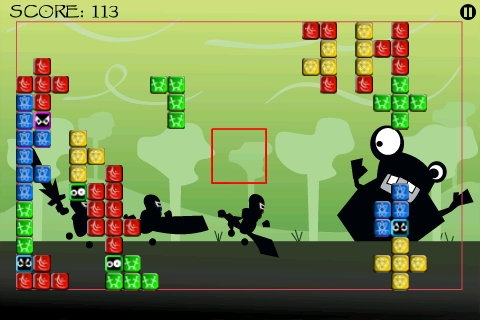
Every puzzler claims to be the iPhone's knight in shining armour, trumpeting the finger as mightier than the sword. Block Knights wields a different weapon in its quest for App Store glory: the accelerometer.
By employing motion controls for puzzle-solving, the game earns due credit for invention, yet it doesn't grant it a seat at the round table.
Your only objective in Block Knights is to clear lines from the screen. Situating various shaped blocks that appear at the screen's centre, your aim is to create horizontal or vertical lines.
Tilting your handset enables you to move blocks, while holding still for a second sets the block in place. Tapping the shape rotates it, which helps in fitting the unusual combination of blocks together to form lines.
Shapes range from large T- and L-configurations to easily placed lines and awkward S-formed blocks. Manipulating them into lines is challenging, but only because you can't do so cleanly.
Blocks clutter the screen as you strive to create lines, odd shapes cast aside and bits of those used jutting out from your constructed line. Unlike the neat arrangements possible in Tetris, expect lots of gaps and unfilled pockets.
This makes Block Knights a hearty challenge even before the introduction of mode-specific elements. Arranging the random assortment of blocks is awkward enough, but this difficulty is compounded by questionable employment of the accelerometer for movement.
Tips and tilts are not the best means of managing blocks, particularly given the difficulty in actually setting the blocks in place. The slightest movement of your handset can mean the difference between a perfectly-placed shape and one that ruins the game.
In Infinitas mode, you're free to focus on mastering the controls and creating lines without worry about time limits or any other complication. It's the ideal mode for learning the game, serving as a squire before attaining knighthood. Much harder are Quest, Arcadia, and Guillotine modes.
Quest is billed as the game's main attraction, tasking you with the elimination of block-shaped enemies called mobs. Dispatching these enemy blocks requires creating a line around them.
Naturally, the number of mobs increases with each passing stage. Mobs also sit at precarious spots on the screen, which makes them difficult to destroy. Tactics play an important role due to the need to conserve screen space, minimize block waste, and eliminate mobs quickly.
Arcadia and Guillotine move away from the mobs and instead wind up the clock. A gauge along the bottom of the screen decreases as time passes in Arcadia, the goal being to create lines to replenish the gauge.
Guillotine sees the clock tied to the placement of each shape. Time resets as soon as you set down a block. Both are riddled with anxiety, the tactical tinge of Quest replaced with a sense of urgency.
The distinction among modes is not only clear, but meaningful. Block Knights caters to variety as a result. That variety would be more pronounced if the fundamental mechanics of play were more finely tuned, though.
The lack of intuitive control prevents a realisation of full potential, the boon of variety and invention in gameplay jousted by control issues.
Block Knights

